21 BLACK Birds With YELLOW WINGS (ID Guide With Photos)
Did you recently come across a black bird with yellow wings, and want to know what species it was?
Identifying black birds that have yellow on their wings is not as easy as it might seem, since there are surprisingly many birds in the world that fit this description.
To help you identify the bird you saw, we’ll cover the most important black birds with yellow on their wings in this article.
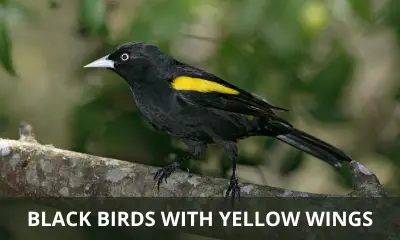
What are the types of black birds with yellow wings?
There are 21 types of birds that have a black body and yellow wings, which are covered in full detail below.
Golden-winged Cacique
Scientific name: Cacicus chrysopterus
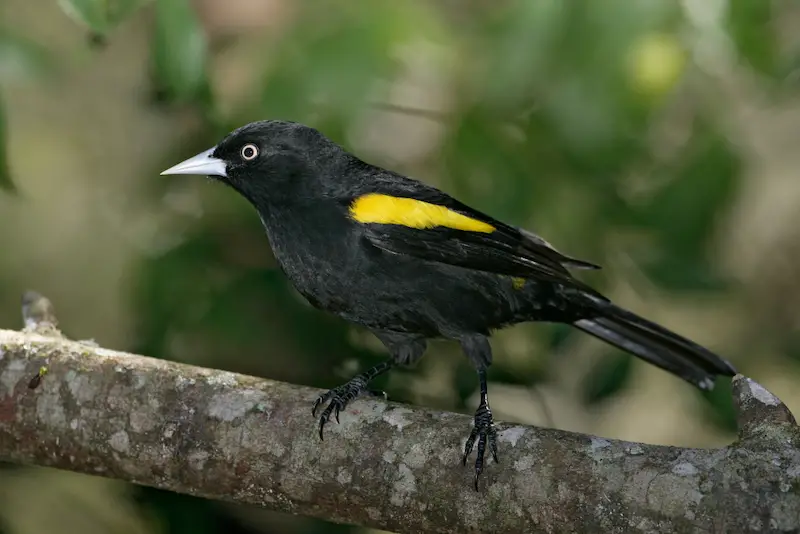
The Golden-winged Cacique is a locally common breeding bird in mountain forests of Paraguay, Uruguay, and other parts of southern South America.
These handsome birds are largely black, but have a brilliant yellow patch on their inner wing, which looks like a shoulder patch when the wings are folded.
Usually found in dense forests, where they build a long nest that is suspended from a branch.
Yellow-winged Cacique
Scientific name: Cassiculus melanicterus

This cacique is larger than the previous species, and although they look superficially similar, their ranges don’t overlap.
Yellow-winged Caciques are only found in Mexico and Guatemala, where they inhabit lowland deciduous forests.
These stunning yellow and black birds are easy to identify, due to their black bodies with yellow feathers on their wings, rump, and tail edges.
Yellow-rumped Cacique
Scientific name: Cacicus cela
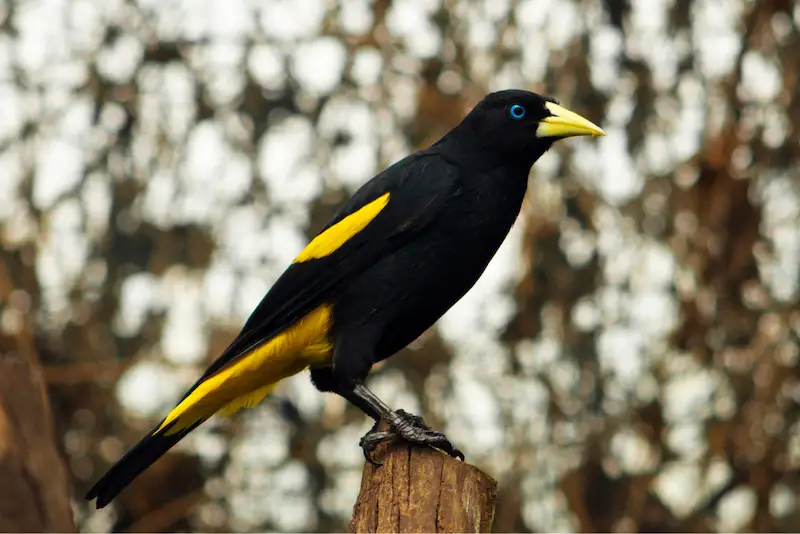
This beautiful cacique looks similar to the Yellow-winged Cacique, but is found in a non-overlapping range in northern South America.
These black birds have bright yellow wing patches, a yellow undertail and yellow rump. Another great distinguishing feature are their pale blue eyes.
They nest in colonies, and build hanging nests that look like suspended pouches.
Mountain Cacique
Scientific name: Cacicus chrysonotus

Image source: Andy Morffew, CC BY 2.0, via Wikimedia Commons (cropped)
This striking cacique is entirely black, except for its bright yellow shoulder patches and rump. Both sexes are similar.
It is found in mountain forests of the Andes, from Columbia down to Bolivia, and lives at altitudes above 1,700 meters.
The Mountain Cacique is often encountered in flocks, often mixed with other birds, such as jays.
Yellow-winged Blackbird
Scientific name: Agelasticus thilius
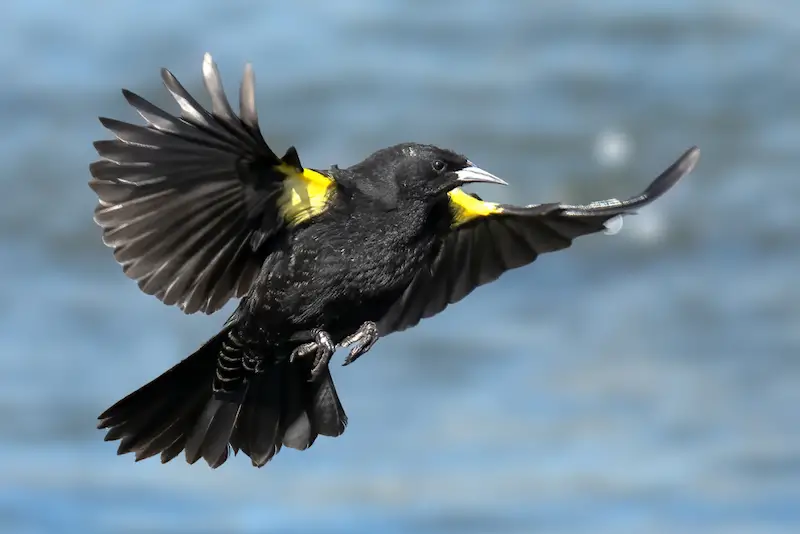
Image source: jotallilo, CC BY 2.0, via Wikimedia Commons (cropped)
This gorgeous blackbird is found in wetlands and close to bodies of freshwater in southern South America.
Males are entirely black, except for a bright yellow patch on their shoulder, which variably extends along the front of their wings.
Females are dark brown with buff streaks and spots, and look similar to immature birds.
Yellow-winged Blackbirds are very social, nesting in colonies and foraging together in small groups.
Yellow-shouldered Blackbird
Scientific name: Agelaius xanthomus
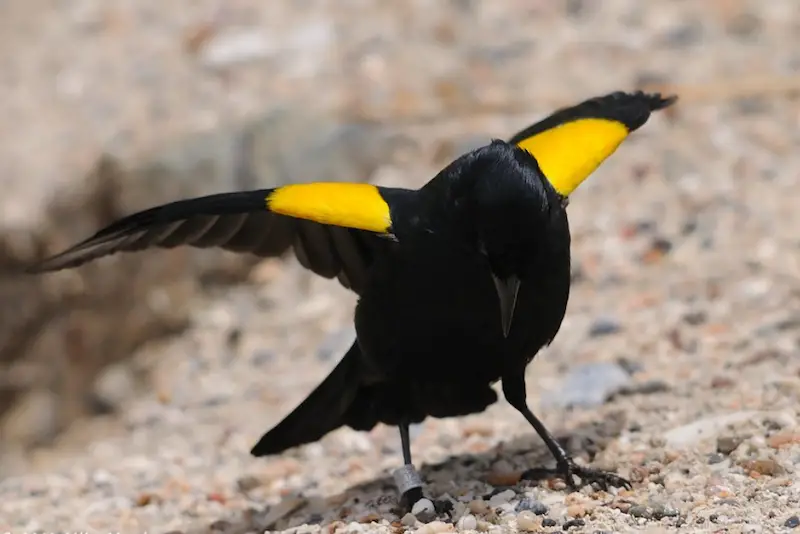
Image source: Mike Morel, CC BY 2.0, via Wikimedia Commons (cropped)
While the Yellow-shouldered Blackbird looks very similar to the Yellow-winged Blackbird, it has a non-overlapping range, and is only found in Puerto Rico, where it inhabits coastal mangrove forests.
It is entirely black, except for its canary yellow shoulder patches. The yellow feathers tend to be hidden when it is perched, but flash brightly when it takes to the wing.
This is another social icterid, and is most often encountered in flocks.
Red-winged Blackbird
Scientific name: Agelaius phoeniceus

The Red-winged Blackbird is the only species on this list that is found in North America, where it is one of the most abundant blackbird species.
Male Red-winged Blackbirds are completely black except for the bright yellowish orange patches on their shoulders and upper wings.
In contrast, females (and juveniles) are a blackish brown color with white streaks.
Generally speaking, this small bird lives in open fields and near water. It is often found in marshes, wetlands, and around lakes, and also visits feeders.
To find food, the Red-winged Blackbird travels many miles a day, especially outside of the nesting season.
While this blackbird is primarily a seed-eater during fall and spring, it switches to feeding almost exclusively on insects during summer.
Depending on where it is found, the Red-winged Blackbird is either a seasonal migrant (in the north of its range), or a resident (in the south of its range).
Red-winged Blackbirds roost in flocks up to millions of birds strong, creating a deafening noise with their rapidly beating wings.
In spring, males are usually the first ones to arrive in order to claim a desirable territory before the females arrive.
During the mating season, the male sings from a conspicuous perch and display the red shoulder patches on his feathers in order to attract the attention of females.
After a female chooses a mate, she builds her nest over shallow water in a thick stand of vegetation. Her chosen mate then aggressively defends the nest against other blackbirds.
The most successful males are bigamous, and can mate with multiple females at the same time.
Black Siskin
Scientific name: Spinus atratus
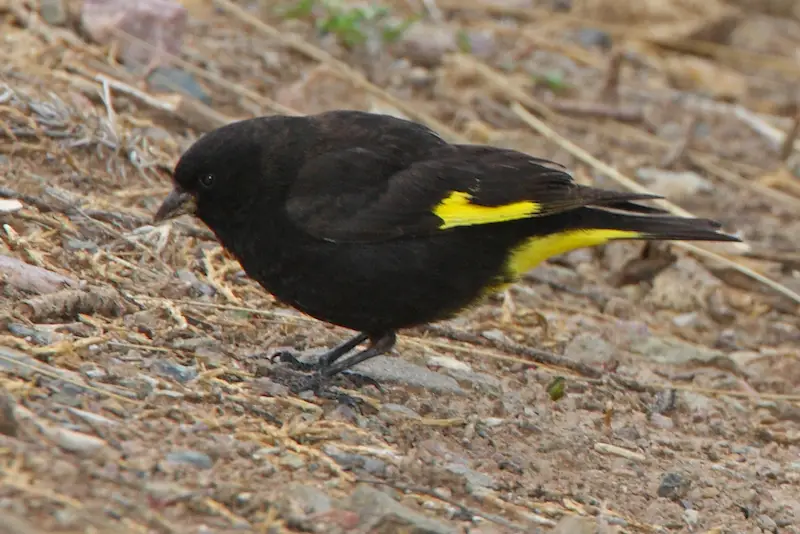
This small finch is found in coastal areas of the central West Coast of South America, where it inhabits grassland, scrub land and marshes.
Males are largely black, except for their bright yellow wing feathers, undertail, and tail patches.
This small black finch with yellow wings is usually encountered foraging for seeds on the ground in small groups.
Yellow-bellied Siskin
Scientific name: Spinus xanthogastrus

Image source: Julian Londono, CC BY 2.0, via Wikimedia Commons (cropped)
This brightly colored finch inhabits woodland clearings and edges in northern South America. Males have a black hook and black back, contrasting with its yellow wings and belly.
Females are more drab, and look like small pale yellow birds, as do immature birds. However, both sexes and immature birds still have the characteristic yellow wing patch.
Golden-winged Sunbird
Scientific name: Drepanorhynchus reichenowi
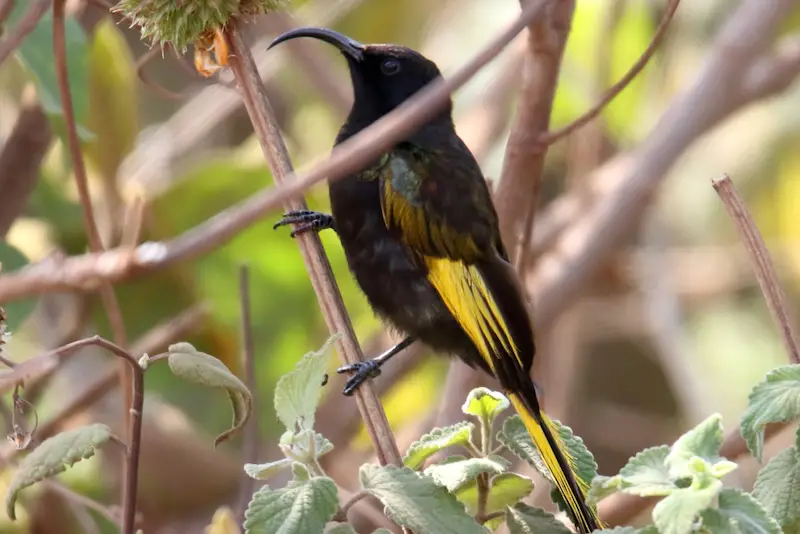
Image source: Dominic Sherony, CC BY 2.0, via Wikimedia Commons (cropped)
This large sunbird is found in eastern Africa, where it inhabits montane forests and grassland. It is easily recognized by its long curved bill, as well as the long yellow tail
Males are largely black, but have yellow patches in their wings, as well as in their tail. Females are light brown, but also have yellow panels in their wings.
These black and yellow birds feed on the nectar of flowers as their predominant food source, but also feed on insects during the breeding season.
Regent Bowerbird
Scientific name: Sericulus chrysocephalus
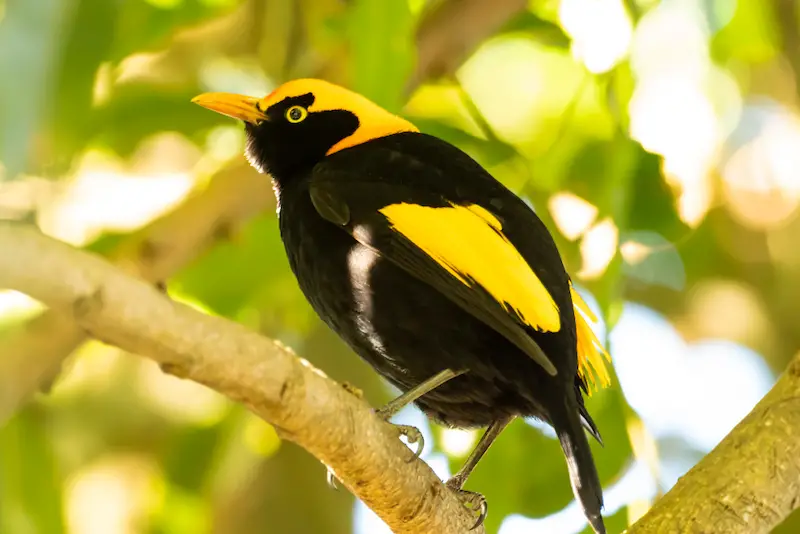
These eastern Australian birds inhabit coastal rainforests, where they are shy and hard to observe.
The male looks stunning with its black body and golden crown and golden wings. Females and immatures look completely different, and are light brown with a speckled breast.
The males construct bowers in the jungle, where they perform courtship displays to attract females.
Golden-winged Manakin
Scientific name: Masius chrysopterus
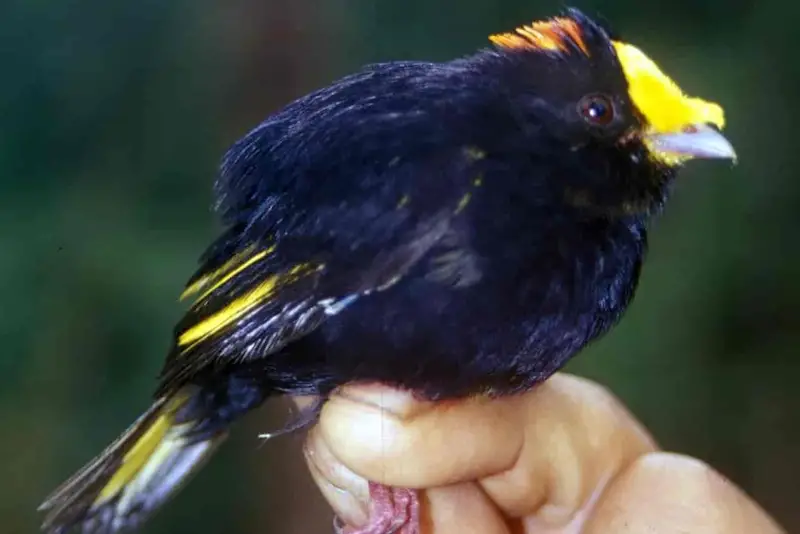
Image source: Ana Agreda, Public Domain, via Wikimedia Commons (cropped)
This small manakin inhabits high altitude forests in the Andes in northern South America. The male is jet black except for its golden crown.
And although the wings have a golden patch, this is usually not visible when the birds are perched, but flashes bright when a Golden-winged Manakin flies from one tree to another.
Females are more inconspicuous, and are drab greenish yellow in color. The males like to gather in small groups for their courtship displays.
Variable Oriole
Scientific name: Icterus pyrrhopterus
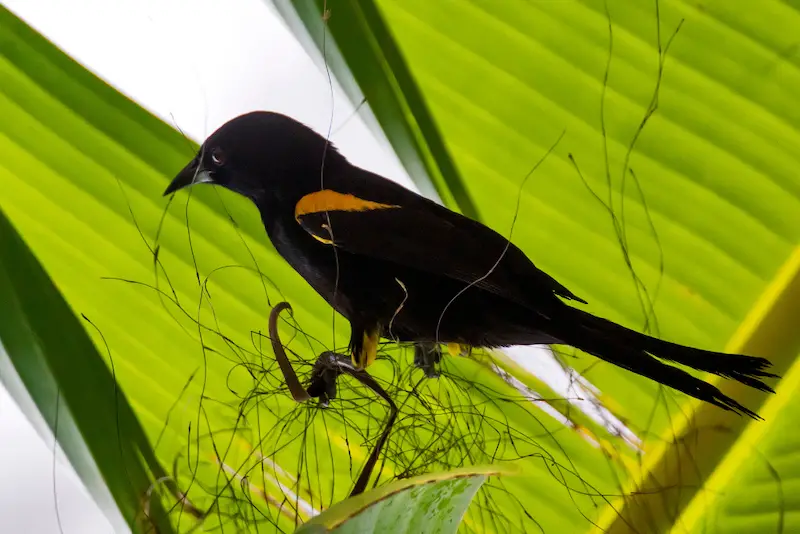
This medium-sized oriole is a bird of forest edges and scrub land in eastern South America. The sexes are similar and look entirely black, apart from their egg yolk yellow wings and thighs.
There are several different subspecies, some of which lack the yellow thighs, and some of which have chestnut colored wing patches.
Epaulet Oriole
Scientific name: Icterus cayanensis
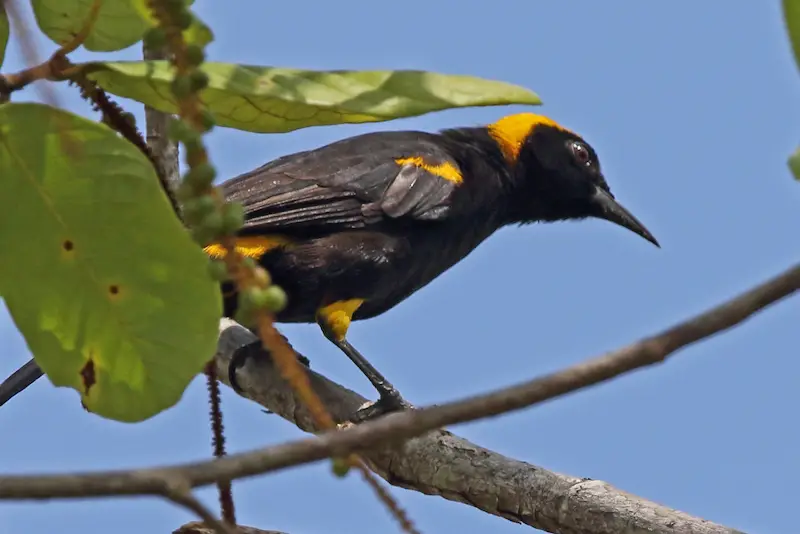
This small oriole inhabits lowland rainforests in northern South America, and is often found close to water.
Both sexes are alike and are generally black, except for golden yellow wing bars, rump and hood.
Similar to the previous species, there are several subspecies, some of which lack the yellow hood and rump.
St. Lucia Oriole
Scientific name: Icterus laudabilis
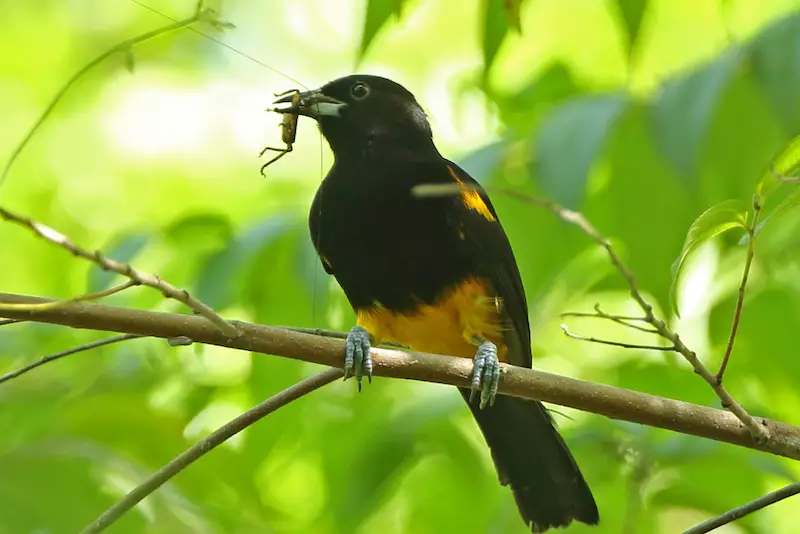
This brightly colored oriole is only found on the main island of St. Lucia, south of Martinique, where it inhabits humid montane and coastal forests.
The male is largely black, apart from its orange-yellow shoulders, yellow belly, and rump. The female looks similar, but is a little more drab and less brightly colored.
Hispaniolan Oriole
Scientific name: Icterus dominicensis

This oriole has a similarly restricted range to the previous species, and is only found on the island of Hispaniola (which belongs to both Haiti and the Dominican Republic).
Both sexes look similar and are mostly black, apart from the yellow patches on their wings, bellies, and rump.
This oriole prefers coastal rainforest, though it also occurs up to an elevation of 700 feet. It is often found nesting in palm trees.
Golden-crested Mynah
Scientific name: Ampeliceps coronatus
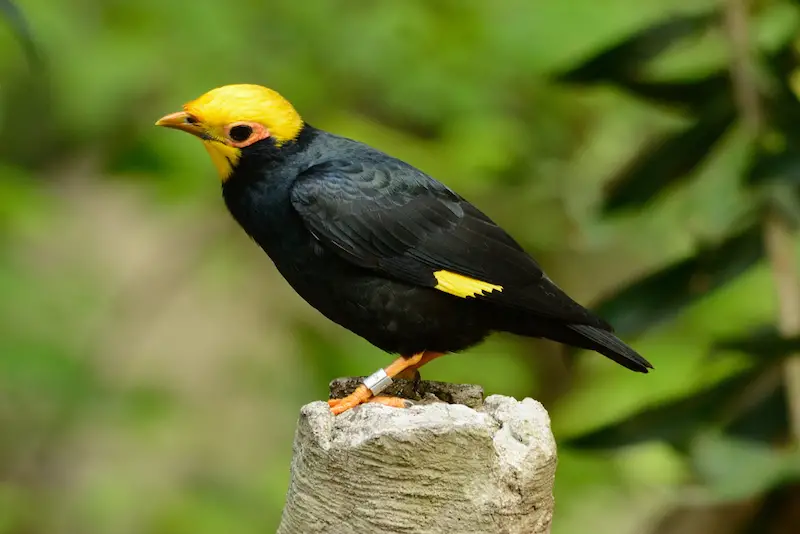
The Golden-crested Mynah is a bird of lowland forests in Southeast Asia from Bhutan to Malaysia.
It has a glossy black body with a patch of bright yellow on the wings, as well as a golden crown. Females look similar, but lack the golden crown.
These mynahs are often encountered foraging in pairs or small groups that fly from tree to tree.
Montane Widowbird
Scientific name: Euplectes psammacromius
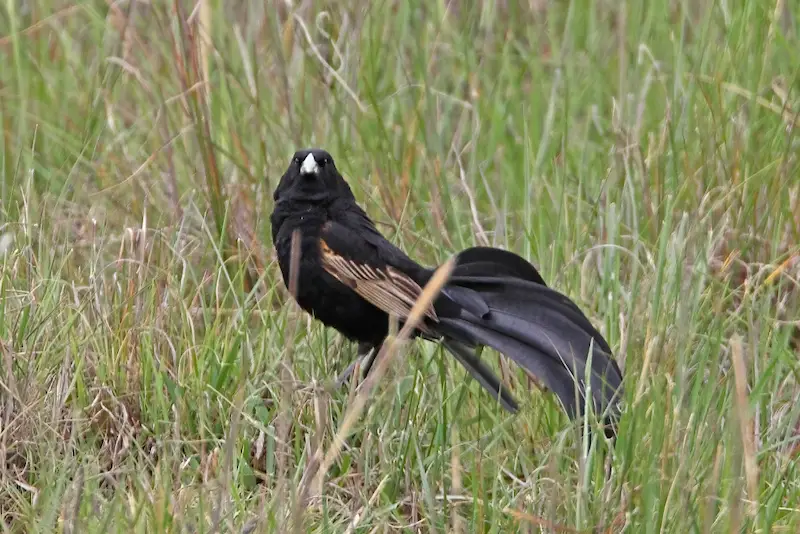
Similar to other widowbirds, males are easily recognizable due to their extra long tail. They are mostly black with a yellow shoulder patch that fades into buff gray on the wings.
It inhabits a range of open mountain habitats in East Africa that include grassland and marshes.
While the females resemble the females of other species, the best way to identify them is by their male.
Yellow-mantled Widowbird
Scientific name: Euplectes macroura

The Yellow-mantled Widowbird has a shorter tail than the aforementioned species, and is found across many areas of Central Africa.
Males are spectacular black-and-yellow birds, with a jet black body and canary yellow shoulder patches. There are several subspecies, which have larger or smaller areas with yellow plumage.
Females look like small brown streaked sparrows, and are best identified via their associated male. These birds are found in a variety of open habitats, such as moist grasslands and marshes.
Yellow Bishop
Scientific name: Euplectes capensis

This colorful weaver bird is found in the southern half of Africa, where it is a common bird in the cape region.
Males are all-black apart from yellow shoulder patches on their wings, and a yellow rump, while females are dark brown with light streaks.
It favors open habitats, including scrub land and grassland, where it is encountered foraging in small groups outside of the breeding season.
Black-and-gold Cotinga
Scientific name: Lipaugus ater

This large cotinga species has a restricted range in southeastern Brazil, where it is found in montane forests close to Rio de Janeiro.
Males are all black with yellow patches on their wings, as well as bright orange beaks that add to the contrast.
Females are drab olive-green, and easy to overlook in dense foliage.
New Holland Honeyeater
Scientific name: Phylidonyris novaehollandiae
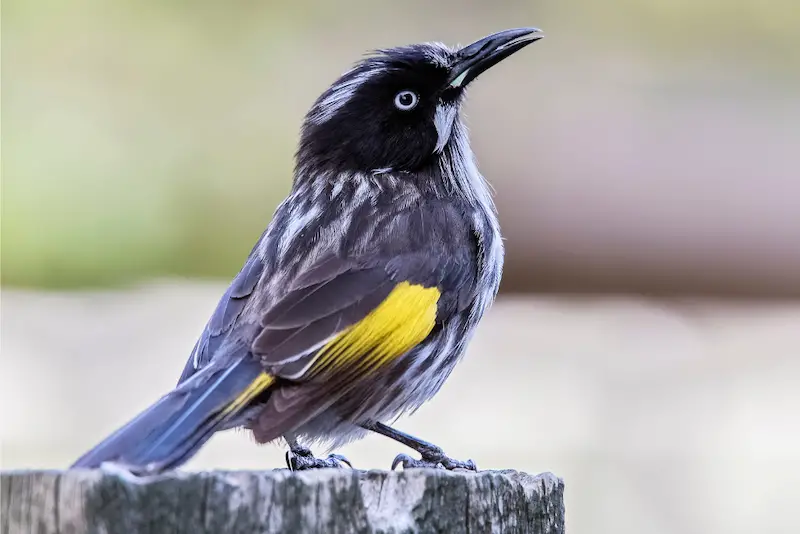
This beautiful honeyeater is found in the coastal habitats of southern Australia and Tasmania, where it also often occurs in urban gardens.
Both sexes look alike, and have a black back, shoulders and head, as well as yellow panels on their wings and tails.
While it mainly feeds on nectar, it also includes insects in its diet, especially during the breeding season.
Final remarks
In summary, here are the 21 types of black birds with yellow on wings:
- Golden-winged Cacique
- Yellow-winged Cacique
- Yellow-rumped Cacique
- Mountain Cacique
- Yellow-winged Blackbird
- Yellow-shouldered Blackbird
- Red-winged Blackbird
- Black Siskin
- Yellow-bellied Siskin
- Golden-winged Sunbird
- Regent Bowerbird
- Golden-winged Manakin
- Variable Oriole
- Epaulet Oriole
- St. Lucia Oriole
- Hispaniolan Oriole
- Golden-crested Mynah
- Montane Widowbird
- Yellow-mantled Widowbird
- Yellow Bishop
- Black-and-gold Cotinga
- New Holland Honeyeater
If you’ve spotted one of these birds while bird watching, hopefully this ID guide will help you identify it quickly and easily.
And if you enjoyed this article, check out our guide to the black and red birds.
